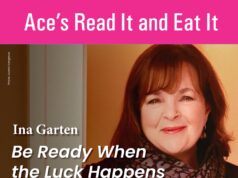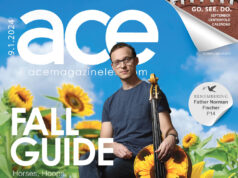Garry Bibbs
Artist with Hustle
Elizabeth Kinkead
Lexington artist Gary Bibbs recently won the prestigious Arts Federation/National Endowment for the Arts 1994 Regional Visual Arts Fellowship for printmaking. His “Black Art, Black Steel, Black Man,” a solo exhibit featuring both prints and sculptures, is currently on display at ArtsPlace through January 17, 1995.

Bibbs estimates that he can produce 20-30 prints and 2-3 sculptures a month. “I’m an extremely intense artist,”he declares, and he believes it is his intensity, or what he calls “hustle,” that has gotten him where he is today.
In addition to teaching sculpture and printmaking full-time, Bibbs tirelessly exhibits his work in cities across the east, including Indianapolis, Chicago, Winston-Salem, Atlanta, and Louisville. But, he says, “Doing commission work is really where my heart is-I really want to get my work out to large public places.” In 1992, he completed a stainless steel sculpture entitled “Life, Family and Good Health” for the Kentucky Medical Service Foundation and two other commissions, a stainless steel sculpture for the Louisville Fire Department and one for Bluegrass Woodworking on Nandino Boulevard in Lexington, are now under way.
I interviewed Bibbs at his studio in the back of the Reynolds Building. When I got there, he had not yet made it to his office. So I waited outside in the open lot surrounded by old tobacco warehouses not converted into various art facilities. It was a dreary, misty morning and the rubble, puddles of water, scrap metal, and outcast, rusted, alien-like sculptures that littered the area made me feel like I was in a scene from Paul Verhoeven’s futuristic movie, Total Recall.
When Bibbs arrived (a few minutes late only because he had driven to Louisville and back before our 9 AM meeting) and unlocked his door for me, his office was a haven. Petitioned off from his work space, his poster-lined office was warm and comfortable, complete with a refrigerator and CD player.
Talking with Bibbs, it is not hard to see where his art derives its expression. Often, the characters that he tools out of steel and presses onto paper-savvy, hip, in motion, arms stretched toward the stars-seem to reflect Bibbs’ own ideologies, sensibilities, and personality. You would expect characters like “Christy,” “Fannie Mae,” and numerous unnamed “sisters” and the “kissers,” whom Bibbs portrays in unabashed, primary colors and shameless nudity, to tell it like it is. Likewise, the artist himself does not mince his words.
On being labeled a “southern” artist…
I’m universal, I would say my work more northern. I mean it’s southern in terms of my spirituality, but northern in terms of how I like to promote myself intellectually. That’s a deep work, “southern.” I guess they call my work southern because I’m in the South. I think the South lacks a lot of the hustle sense that you have to have to be more successful. People in the South are more relaxed-sitting on the porch-type-and it annoys me to death because it’s too slow. It doesn’t give me the energy I need. If you look at my works, you’ll notice I’m an expressionist. Expression-I have to be pumped, I have to have something generate my energy. If you ever hear when I’m working (he points to a CD player), I’m in a closed world here; I’m nowhere near Kentucky.
On his success…
It’s the hustle and hard work. What kind of program you set up for yourself in terms of striving, getting your name out, getting people to recognize and purchase your work. I always tell students: work is 90 percent of your success, you’ve got to have good, strong art. The rest will come. There’s a lot of lazy artists out there. This is something you have to do in terms of creativity, your marketing and promotion. You gotta set yourself up almost like an industry. A lot of artists don’t do that-what they’ll do is let an agent come in and run their world and they ‘just make art.’ The 90s is not so much about this; you’re going to have to do a lot more. That’s what I attribute my success to-I got an awful lot more to do, I’m just crackin’ the seal. But I got a hustle set up.
On his art…
My sculpture and print are starting to come together; I’ve noticed that. And this is happening without my being conscious of it. Sculptures do take longer to produce. It takes longer for me to grasp what you call the vocabulary. See, I have a full vocabulary for my prints. I can walk up to the plate and I can just start pulling things from my memory banks. It [his vocabulary] is like A to Z. I have different forms that represent and mean different things. I have a certain image for a sun, my females, my males, homes, churches, my albums. It’s a wide spectrum. When I walk up to the plate I already have an approach. I record those things, and as I work they will develop into a concept. As I work, I’ll also recreate and I’ll invent some more vocabularies. So it’s like making language. That’s how I always explain abstraction to people.
On his exhibit at ArtsPlace…
I’m going to tell you the truth about this exhibit tonight. I had already said I didn’t want to show because it’s not a big market of people purchasing works. All of the work that goes behind putting it in there, you know, you want something out of it. You want to at least move a piece or get a decent story out of it. I was invited to the show and I helped do my best to make a lot of changes. I don’t like the way ArtsPlace handles artists in Lexington because if it’s a one-person show, I think it should be spectacular. Play it up. That’s the only way you get people aroused.
You go to openings here, and it’s the same people, same crowd, come eat up all your food, look at your work-“nice work” [they say]-then they’re out of there.
On working in Kentucky…
[I don’t see myself staying here] a whole lifetime. This is a Godly thing. God is telling me how he wants me to do this. I usually listen to Him. It seems like every five years, He shifts me somewhere. It’s like a five year span, every five years something pulls me to another area. I’m just waiting to see, I’m going to wait and see where my next moves are. It would be wonderful if Kentucky picked up in terms of the art market, but it’s just horrible. And it’s not the fact that people don’t like art; I think it’s the fact that people who run whatever and sit on whatever committee don’t bring up this concept [art]. It would be great if they adopted the 1 percent art clause that they have in places like Chicago [each city project that goes up has to set aside a 1 percent budget for art]. Kentucky could do that. You look at the downtown area, when buildings go up, what do they put out in front? A fountain. That’s the work of an architect. He’ll see that extra $50,000. There’s no one on the planning committee that says “Hey, we want a piece of art.”
This city is so ignorant about what it takes to put a piece [of art] out. I mean $30-50,000 will definitely get a sculpture-maintenance free. Fountains are off in the fall. They just sit there.





